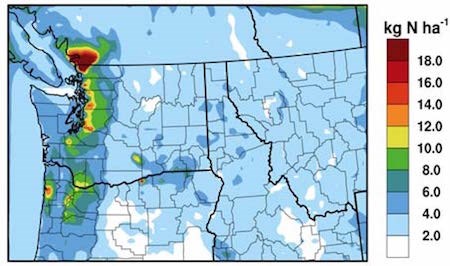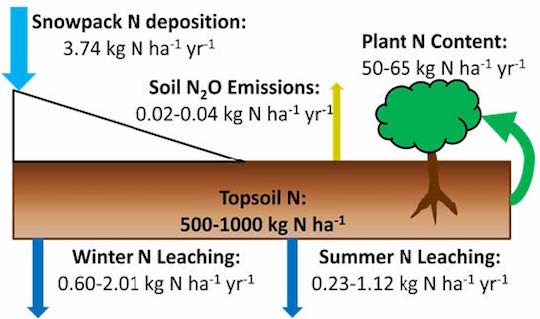Last updated: August 15, 2017
Article
Community responses to atmospheric nitrogen deposition in subalpine meadow ecosystems at Mount Rainier National Park

Importance
This research focuses on the impacts of atmospheric nitrogen deposition on the health of subalpine ecosystems. Subalpine ecosystems provide important resources for Mount Rainier National Park. They act as carbon sinks that slow the greenhouse effect and can absorb atmospheric pollutants that deposit in rain and snowfall. Additionally, they support a famous diversity of wildflowers that provides forage for wildlife and brings visitors to the Park (Fig. 1). However, these important resources may be diminishing due to increases in atmospheric nitrogen deposition.
Atmospheric nitrogen (N) deposition occurs when reactive N gases in the atmosphere fall out with precipitation or attach to airborne particles, like dust or pollen. Reactive N gases are released into the atmosphere by automobile or industrial emissions or by the volatilization of fertilizer applied to farmland. Although small amounts of N can improve plant growth, large amounts of N deposition has been to shown to saturate ecosystems (Aber et al., 1989). Saturation can cause N to leak out of alpine ecosystems, either through emissions of nitrous oxide (N2O), a potent greenhouse gas, or through leaching to watersheds as well as alter community composition in alpine meadows (Aber et al., 1989; Bowman and Steltzer). This leaching can cause pollution of mountain lakes and streams through acidification and algal growth, which negatively impact their quality for recreation and as drinking water (Williams and Tonnessen, 2000). Thus, increases in N deposition could have negative impacts for Mount Rainier and high-elevation ecosystems throughout the Cascades.
This research measured ambient N deposition rates and investigated how three subalpine vegetation communities respond to N deposition by their capacity to store or emit N. We measured how much N was stored in plant and soil microbial biomass compared to how much was lost through N2O emissions or N leaching to watersheds in each vegetation community. This study will help the National Park Service determine to what extent N deposition is causing damage to the ecosystems under their management.

Status and Trends
Researchers have measured rates of N deposition between 1.5 to 30 kg N ha-1 yr-1 (3x to 30x natural background rates) throughout the Pacific Northwest (Holland et al., 1999; Fenn et al., 2007; NADP, 2012). Subalpine ecosystems, which receive larger proportions of precipitation than lower elevations, have been shown to receive higher rates of N deposition as well (Fenn et al., 2003). Model projections suggest that may of the subalpine ecosystems in the Cascades may be subject to N deposition rates between 4.0 to 8.0 kg N ha-1 yr-1 (Fig. 2) (Herron-Thorpe et al., 2012). At similar rates in the Rockies, N deposition has lead to increased soil N leaching and nitrate in alpine streams and lakes, causing acidification and changes in algal communities (Baron et al., 2000; Rueth and Baron, 2002). However, whether N deposition is causing detrimental impacts to high-elevation ecosystems in the Cascades has yet to be determined.

Discussion
Research in 2013 by the primary investigator has indicated that N deposition rates in the Cascades may be higher than previously expected and that subalpine vegetation communities have distinct responses to N deposition (Fig. 3). Snowpack N deposition measurements showed that current winter N deposition levels at Mount Rainier reach 3.74 kg N ha-1 yr-1, which is similar to rates measured in other studies in the Park (Agren et al., 2012; Poinsatte et al., 2014). This suggests that subalpine ecosystems in the Cascades may potentially be nearing their expected threshold for increased N leaching, based on the threshold for similar ecosystems in the Rockies (Williams and Tonnessen, 2000). Soil N2O emissions, soil N leaching, and plant N uptake measurements in 2013 indicated that subalpine vegetation communities partitioned the N deposition in different ways. Emissions of N2O were highest in the black alpine sedge (Carex nigricans) community, while the sitka valerian (Valeriana stitchensis) community had the highest N leaching rates, and the pink mountain-heath (Phyllodoce empetriformis) community had the lowest N uptake (Poinsatte et al., 2014). Thus, the sitka valerian and black alpine sedge communities may be more susceptible to detrimental impacts from elevated N deposition than the pink mountain-heath community. These results can inform regulatory agencies on how urban and agricultural N emissions impact N deposition and the National Park Service on how elevated N deposition affects sensitive ecosystems.
Literature Cited
- Aber, J.D, K.J. Nadelhoffer, P. Steudler, and J.M. Melillo. 1989. Nitrogen saturation in northern forest ecosystems. Bioscience 39:377-386.
- Agren, J., N. Beebe, and A.M. Johansen. 2012. Precipitation chemistry at Mount Rainier (Paradise Ranger Station) collection site: Final report for data collected between June 1, 2011 and May 30, 2012. Central Washington University, Ellensburg, WA.
- Baron, J.S., H.M. Rueth, et al. 2000. Ecosystem responses to nitrogen deposition in the Colorado Front Range. Ecosystems 3:352-368.
- Bowman, W.D. and H. Steltzer. 1998. Positive feedbacks to anthropogenic nitrogen deposition in Rocky Mountain alpine tundra. Ambio 27:7:514-517.
- Fenn, M.E., J.S. Baron, et al.. 2003. Ecological effects of nitrogen deposition in the western United States. Bioscience 53:4:404-420.
- Fenn, M.E., L. Geiser, et al. 2007. Atmospheric deposition inputs and effects on lichen chemistry and indicator species in the Columbia River Gorge, USA. Environmental Pollution 146:77-91.
- Herron-Thorpe, F.L., G.H. Mount, et al. 2012. Regional air-quality forecasting for the Pacific Northwest using MOPITT/TERRA assimilation carbon monoxide MOZART-4 forecasts as a near real-time boundary condition. Atmospheric Chemistry and Physics 12:5603-5615.
- Holland, E.A., F.J. Dentener, B.H. Braswell, and J.M. Sulzman. 1999. Contemporary and pre-industrial global reactive nitrogen budgets. Biogeochemistry 46:7-43.
- National Atmospheric Deposition Program (NRSP-3). 2012. NADP Program Office, Illinois State Water Survey, Champaign, IL 61820.
- Poinsatte, J., R. Rochefort, L. Whiteaker, and R.D. Evans. 2014. Community-specific biogeochemical responses to atmospheric nitrogen deposition in subalpine ecosystems. Northwest Scientific Association 2014 Meeting.
- Williams, M.W. and K.A. Tonnessen. 2000. Critical loads for inorganic nitrogen deposition in the Colorado Front Range, USA. Ecological Applications 10:164-1655.
